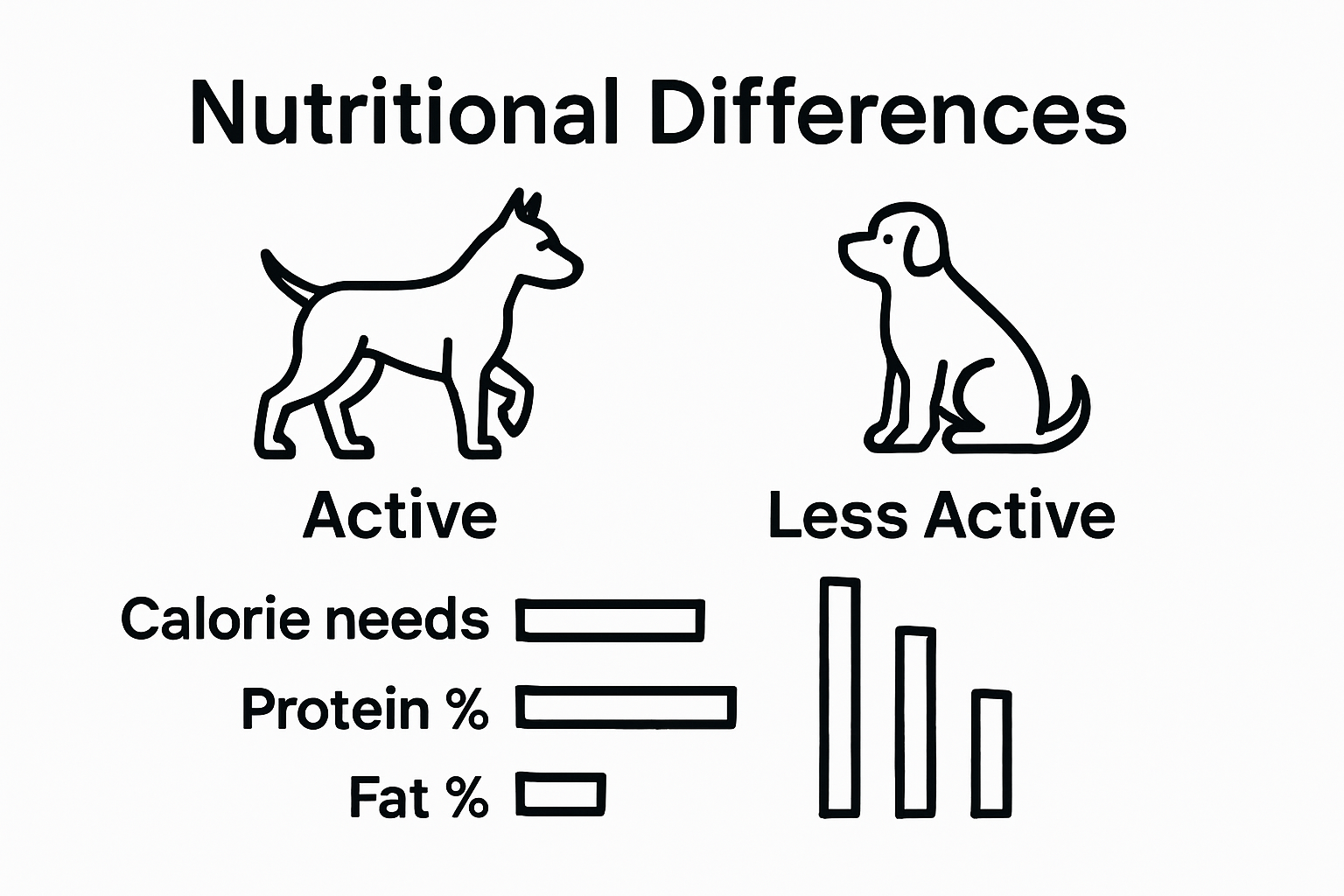
Understanding Dog Food for Active Dogs: Nutrition Explained
Share
Active dogs burn far more energy than their sleepy companions. It is not just a little difference – their bodies can require up to double the caloric intake compared to sedentary dogs. Most people assume feeding them more of the same food will do the trick. The truth is, active dogs need a completely different nutritional approach, or they risk running out of steam long before the finish line.
To clarify the distinct nutritional needs of active versus sedentary dogs, the following comparison outlines key differences in their dietary requirements.
| Aspect | Active Dogs | Sedentary Dogs |
|---|---|---|
| Caloric Intake | Up to double the amount of sedentary dogs | Lower energy needs |
| Protein Requirement | High, for muscle maintenance and recovery | Moderate |
| Fat Content | Increased, for sustained energy release | Lower |
| Carbohydrate Utilisation | Carefully selected complex carbs for consistent energy | Basic carbohydrate sources |
| Micronutrient Focus | Enhanced for cardiovascular and muscular health | Standard requirements |
| Ingredient Quality | Preferably fresh, whole, human-grade | Can include more processed ingredients |
| Nutritional Approach | Precision-formulated, tailored to individual activity | One-size-fits-all formulations may suffice |
Table of Contents
- What Is Dog Food For Active Dogs?
- Why Nutritional Balance Matters For Active Dogs
- How Ingredients Influence Energy Levels And Health
- Key Considerations For Choosing The Right Dog Food
- Understanding Breed And Life Stage Specific Nutrition
Quick Summary
| Takeaway | Explanation |
|---|---|
| Active dogs need high-protein diets | Increased protein supports muscle maintenance and recovery for high-energy canines. |
| Adjust nutrition based on activity level | Tailor dog food formulations to meet specific energy requirements of each dog’s activity intensity. |
| Ingredient quality affects performance | Fresh, whole ingredients provide better nutrient absorption, enhancing metabolic efficiency in active dogs. |
| Monitor breed and life stage needs | Different breeds and life stages require unique dietary adjustments for optimal health and performance. |
| Nutritional balance prevents health issues | Precise nutrient ratio prevents reduced endurance, sluggish recovery, and long-term health complications. |
What is Dog Food for Active Dogs?
Dog food for active dogs represents a specialized nutritional approach designed to meet the unique energy requirements and metabolic demands of high-performance canines. Research from the American Veterinary Medical Association indicates that active dogs have significantly different nutritional needs compared to sedentary pets.
The Metabolic Demands of Active Dogs
Active dogs including working breeds, athletic dogs, and those participating in regular intense physical activities require dog food that provides higher caloric density and carefully balanced nutritional profiles.
 These dogs burn substantially more energy through exercise, training, and physical exertion, necessitating food formulations that can rapidly replenish nutrients and support muscle recovery.
These dogs burn substantially more energy through exercise, training, and physical exertion, necessitating food formulations that can rapidly replenish nutrients and support muscle recovery.
Key nutritional characteristics of dog food for active dogs typically include:
- Higher protein content to support muscle maintenance and repair
- Increased fat percentages for sustained energy release
- Enhanced micronutrient profiles supporting cardiovascular and muscular health
- Carefully selected complex carbohydrates for consistent energy delivery
Nutrient Composition and Performance Support
Understanding the specific nutritional requirements means recognizing that active dogs metabolize nutrients differently. Their digestive systems require food that can be quickly absorbed and efficiently converted into usable energy. Our comprehensive guide on life stage nutrition provides deeper insights into how dietary needs evolve with a dog’s activity level.
Our freshly prepared kibble, gentle cooked at 82°C, ensures that human-grade ingredients retain maximum nutritional integrity. By incorporating prebiotics like MOS and FOS, we support not just energy requirements but also digestive health critical for active dogs. The careful preparation method locks in essential nutrients, making our dog food an optimal choice for canines with high metabolic demands.
Why Nutritional Balance Matters for Active Dogs
Nutritional balance represents a critical foundation for maintaining optimal health and performance in active dogs. Research from the Journal of Veterinary Internal Medicine emphasizes that precise nutrient proportions are fundamental to supporting high-energy canine metabolic processes.
The Physiological Impact of Nutritional Imbalance
Active dogs operate under significantly higher metabolic stress compared to sedentary pets.
Nutritional imbalances can lead to profound physiological consequences, including reduced muscle recovery, diminished energy reserves, and potential long-term health complications. When nutrient ratios are not precisely calibrated, dogs may experience:
- Decreased muscular endurance
- Compromised immune system functionality
- Slower recovery between physical activities
- Reduced overall athletic performance
Precision Nutrition for Peak Performance
Precision nutrition goes beyond simple calorie counting. Metabolic efficiency depends on micronutrient interactions and macronutrient ratios. Our comprehensive guide on holistic dog nutrition explores how strategic nutritional planning supports comprehensive canine wellness.
Our freshly prepared kibble, meticulously crafted with human-grade ingredients and gentle-cooked at 82°C, ensures optimal nutrient preservation. By incorporating prebiotics like MOS and FOS, we support digestive health and metabolic efficiency. The careful preparation method maintains nutritional integrity, providing active dogs with a scientifically formulated dietary solution that meets their complex physiological demands.
How Ingredients Influence Energy Levels and Health
Research from the National Institutes of Health demonstrates that specific ingredients play a crucial role in determining a dog’s metabolic performance and overall health. The nutritional composition of dog food directly impacts energy production, muscle maintenance, and physiological resilience in active canines.
Protein Quality and Metabolic Function
Protein represents the fundamental building block for muscle development and energy metabolism in active dogs. High-quality animal proteins provide essential amino acids that support rapid muscle recovery, tissue repair, and sustained energy generation. Not all proteins are created equal proteins derived from fresh, human-grade meat sources offer superior bioavailability and nutrient absorption compared to processed or low-grade protein sources.
Key protein characteristics for active dogs include:
- Complete amino acid profiles
- High digestibility rates
- Minimal processing
- Sourced from fresh animal proteins
Fat and Carbohydrate Interactions
Fat serves as a concentrated energy source crucial for prolonged physical activities. Our comprehensive guide on reading dog food ingredients provides deeper insights into selecting optimal nutritional components. Complex carbohydrates and strategically incorporated fats work synergistically to provide sustained energy release, supporting consistent performance and preventing rapid energy depletion.
Our freshly prepared kibble, gentle-cooked at 82°C, ensures that human-grade ingredients retain maximum nutritional integrity. By carefully balancing protein, fat, and complex carbohydrate sources, we create a nutritional profile that supports the unique metabolic demands of active dogs. Prebiotics like MOS and FOS further enhance digestive efficiency, ensuring that every nutrient is effectively utilized for peak canine performance.
Key Considerations for Choosing the Right Dog Food
Research from the veterinary nutrition experts at Cornell University highlights the critical importance of selecting dog food tailored to individual canine needs, particularly for active dogs with unique metabolic requirements.
Assessing Individual Dog Nutritional Profiles
Choosing the right dog food extends far beyond generic recommendations. Active dogs demand nutritional strategies as unique as their individual physiology. Critical factors include age, breed, specific activity levels, and underlying health conditions. Veterinary nutritionists emphasize that a one-size-fits-all approach fails to address the nuanced nutritional demands of different dogs.
Key considerations when selecting dog food include:
- Current body composition and muscle mass
- Frequency and intensity of physical activities
- Breed-specific metabolic characteristics
- Potential allergies or sensitivities
- Current health status and any medical conditions
Evaluating Ingredient Quality and Nutritional Integrity
Our comprehensive guide on understanding kibble versus raw dog food provides deeper insights into nutritional delivery methods. Ingredient quality represents a fundamental determinant of nutritional effectiveness. Freshly prepared, human-grade ingredients processed at precise temperatures ensure maximum nutrient preservation and bioavailability.
Our kibble, meticulously crafted and gentle-cooked at 82°C, represents a scientifically calibrated approach to canine nutrition. By incorporating prebiotics like MOS and FOS, we support comprehensive digestive health while delivering a nutritionally balanced formula specifically designed for active dogs. The careful preparation method maintains ingredient integrity, transforming high-quality proteins and complex carbohydrates into an optimal energy source for peak canine performance.
Understanding Breed and Life Stage Specific Nutrition
Research from the Journal of Animal Science reveals the profound impact of breed-specific and life stage nutritional requirements on canine health and performance. Nutrition is not a universal concept but a nuanced approach tailored to individual physiological characteristics.
The following table summarises how nutrition needs change for dogs across different breeds and life stages, highlighting key considerations for optimal canine health.
| Category | Key Nutritional Focus | Example Considerations |
|---|---|---|
| Large Breeds | Adjusted protein, calorie ratios | Bone, joint support; greater muscle mass |
| Small Breeds | High-energy, dense nutrition | Rapid metabolism; energy expenditure |
| Puppies | High-protein, growth nutrients | Support rapid growth; strong bones, tissues |
| Adult Active Dogs | Balanced protein, fats, micronutrients | Muscle maintenance, sustained energy |
| Senior Dogs | Joint support, muscle preservation | Reduced calorie needs; digestive aid |
Metabolic Variations Across Breed Types
Different dog breeds possess unique metabolic profiles that dramatically influence their nutritional needs. Large breed active dogs, for instance, require different protein and calorie ratios compared to smaller, high-energy breeds. Genetic predispositions, muscle mass composition, and inherent activity levels create substantial variations in nutritional absorption and energy utilization.
Key breed-specific nutritional considerations include:
- Muscle mass development requirements
- Metabolic rate differences
- Genetic predispositions to specific health conditions
- Energy expenditure patterns
- Bone and joint support needs
Life Stage Nutritional Progression
Our comprehensive guide on small breed nutrition provides insights into targeted nutritional strategies. Nutritional requirements evolve dramatically throughout a dog’s life cycle. Puppies demand high-protein diets supporting rapid growth, while senior active dogs require carefully balanced nutrients that maintain muscle mass and support joint health.
Our freshly prepared kibble, gentle-cooked at 82°C, represents a sophisticated approach to canine nutrition. By incorporating prebiotics like MOS and FOS, we create a nutritional profile that adapts to changing metabolic demands. The precise preparation method ensures human-grade ingredients retain maximum nutritional integrity, delivering a tailored solution that supports dogs through every stage of their active lives.

Support Your Active Dog With the Right Nutrition
Active dogs face a unique nutritional challenge: their bodies demand more energy, faster muscle recovery, and a balance of high-quality proteins, fats, and digestible carbohydrates. If you have struggled to find food that truly meets those needs, you are not alone. The article highlights the dangers of poor nutritional balance, which can lead to sluggish performance, reduced endurance, and compromised health. Dogs with demanding exercise routines rely on precise formulations that fuel their energy, aid recovery, and promote lasting well-being.
Discover our science-backed grain-free dry dog food solutions crafted for high-energy pets. These recipes use fresh, human-grade ingredients gently cooked to preserve nutrients and include prebiotics for optimal digestion. For those with large, powerful breeds, our Grain Free Large Breed ALL range supports robust muscle maintenance and peak performance. Explore more at Dry Dog Food | Grain-Free & Science-Backed Kibble to see how we bridge science and nature to meet your dog’s active lifestyle.

Act now to unlock your dog’s best potential. Visit Ultimate Pet Foods today and give your active companion the nutrition tailored to their highest needs. Your dog’s next adventure starts with what you feed them.
Frequently Asked Questions
What should I look for in dog food for active dogs?
Active dogs require dog food with higher protein and fat content, along with complex carbohydrates to provide sustained energy, support muscle maintenance, and aid in recovery after physical activities.
How does the nutritional balance affect active dogs’ performance?
Nutritional balance is critical for active dogs as it helps maintain muscle recovery, energy levels, and overall health. An imbalance can lead to decreased endurance and slower recovery times.
Why are prebiotics important in dog food for active dogs?
Prebiotics like MOS and FOS support digestive health, ensuring efficient nutrient absorption which is vital for active dogs that require rapid replenishment of energy and nutrients.
How do breed-specific and life stage considerations impact dog food choices?
Different breeds and life stages have unique nutritional needs based on their metabolic rates and activity levels. For example, puppies need higher protein for growth, while senior dogs require nutrients that support joint health and maintain muscle mass.
Recommended
- Understanding Life Stage Dog Food: Nutrition by Age – Ultimate Pet Foods
- Create the Perfect Dog Feeding Schedule for Optimal Health – Ultimate Pet Foods
- How to Choose Dog Food: A Step-by-Step Guide for Healthy Dogs – Ultimate Pet Foods
- How Much to Feed Dog: A Complete Guide to Nutrition – Ultimate Pet Foods
